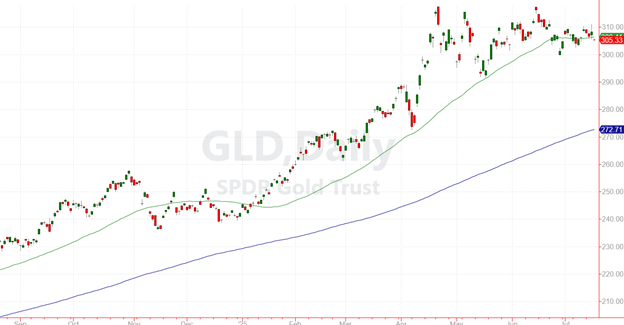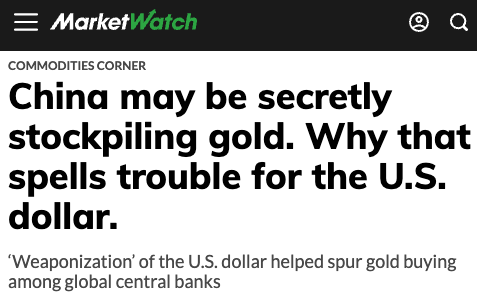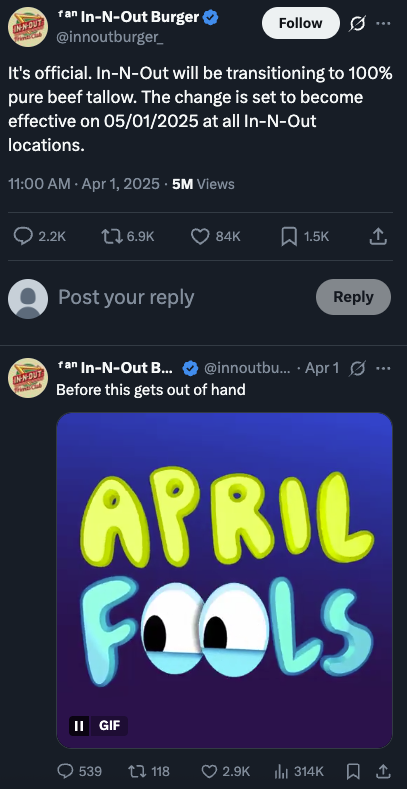A $1.4 Trillion Task
![]() The Alarm Sounds (but Who’s Hearing?)
The Alarm Sounds (but Who’s Hearing?)
 If there weren’t so much drama constantly surrounding this president, maybe his administration could do a more effective job sounding the alarm about AI and electricity.
If there weren’t so much drama constantly surrounding this president, maybe his administration could do a more effective job sounding the alarm about AI and electricity.
Last Thursday, the White House Council of Economic Advisers issued a 23-page white paper. The gist is that unless the capacity of the U.S. power grid grows, the demands placed on the grid by AI will result in spiking electricity prices.
That’s not exactly news if you’ve been reading these daily dispatches for the last 18 months — and especially in recent days.
Indeed, our take is more dire: We’re at risk of rolling blackouts unless something is done.
Anyway, it’s good to see the administration take the issue seriously. It’s done so from the start of the Trump 47 administration last winter, when the president declared a national emergency.
Unfortunately, the white paper’s release got buried in the news cycle — lost in the shuffle of Epstein drama, out-of-nowhere tariff announcements, the swelling in the president’s lower legs…
But it’s worth our attention today, if only for a few moments.
 Here’s one interesting takeaway from the report: "The International Energy Agency (IEA) estimates that by 2030, U.S. data centers will consume more electricity than production of aluminum, steel, cement, chemicals and all other energy-intensive goods combined.”
Here’s one interesting takeaway from the report: "The International Energy Agency (IEA) estimates that by 2030, U.S. data centers will consume more electricity than production of aluminum, steel, cement, chemicals and all other energy-intensive goods combined.”
Another: "The rise in demand for AI and cloud computing capabilities is already driving up electricity use in the United States. After two decades of growth below 1% per year, the demand for electricity grew by 2% in 2024."
Thus, “to effectively compete for AI dominance, the United States must focus on rapid growth of low-cost domestic baseload generation.
“U.S. growth in electricity generation has averaged close to zero over the last 20 years, while China’s generation expanded at annual rates of 5–10% or more."
 In addition, the report says keeping up with growing demand will take another $1.4 trillion of investment between now and 2030.
In addition, the report says keeping up with growing demand will take another $1.4 trillion of investment between now and 2030.
Absent that investment… consumers are looking at ever-spiraling rate increases.
"Using elasticity estimates from economic literature, electricity prices in 2030 could be 9–58% higher as a result of higher demand for power if lower-cost providers don’t come online."
And it’s not just a build-out of grid capacity that’s necessary; it’s also the raw energy to feed the grid.
To meet that need, the report suggests opening up federal lands to more exploration for coal, natural gas and uranium — a recommendation that dovetails perfectly with the “American Birthright” thesis that Paradigm’s Jim Rickards has been telling his readers about all year.
[Editor’s note: As it happens, Jim is anticipating a new development on this front tomorrow.
It’s an event that happens every year like clockwork. Last year, those in the know seized on this development for an especially lucrative trade — leading to a peak gain of 1,161% in only three months.
This year, with the backdrop of the president’s emergency declaration and the release of this white paper, the gains could be even more explosive. If you missed Jim’s briefing on this subject, you owe it to yourself to check it out at this link before tomorrow.]
![]() The Genius Act… and Crypto in Your 401(k)?
The Genius Act… and Crypto in Your 401(k)?
 The “Genius Act” is now U.S. law — and the way we pay for everyday transactions may never be the same.
The “Genius Act” is now U.S. law — and the way we pay for everyday transactions may never be the same.
The House passed the measure Thursday on the heels of Senate approval a month ago — and the president signed it Friday. The law will set “rules of the road” for stablecoins — a form of crypto pegged to the value of a government-issued currency like the U.S. dollar.
Up until now, people have used stablecoins mostly as a place to park their money to easily purchase cryptos that aren’t tied to a fiat currency.
But with a regulatory framework coming into place, it’s likely that stablecoins will come into use for a much broader variety of transactions.
As we chronicled at the start of this month, Walmart and Amazon are both exploring whether to issue their own stablecoins.
When The Wall Street Journal broke the news, the impact was instant on the share prices of Visa and Mastercard — who potentially stand to lose billions in business. That’s because stablecoins would have an unbeatable advantage for retailers: They wouldn’t have to fork over a 2–3% “interchange fee” to the card giants on every transaction.
The Genius Act makes it explicit that players like Walmart and Amazon won’t have to obtain a bank charter to issue a stablecoin.
 The immediate reaction in the crypto market was mixed — and still is as a new week begins.
The immediate reaction in the crypto market was mixed — and still is as a new week begins.
That’s because the House passed two other pieces of crypto legislation Thursday — colleague Chris Campbell summarizes them nicely in Thursday’s edition of Altucher Confidential — but their fate in the Senate is up in the air.
Thus, Bitcoin continues to struggle to surpass its all-time highs; at last check it’s a hair below $119,000. Ethereum has responded more enthusiastically, adding to its already-impressive gains this month; at $3,841 it’s within reach of its late-2024 highs.
 Meanwhile, the president could soon sign an executive order opening up 401(k) plans to crypto.
Meanwhile, the president could soon sign an executive order opening up 401(k) plans to crypto.
So says the Financial Times, citing three anonymous sources. Seems the order will cover gold and private equity as well.
Don’t expect changes immediately: “The executive order would instruct Washington regulatory agencies to investigate the remaining hurdles needed to allow for such alternative investments to be included in professionally managed funds used by 401(k) savers,” says the FT.
How readily the managers of 401(k) plans will embrace these options remains to be seen.
In the meantime, those fortunate enough to have access to a “self-directed” 401(k) can already buy ETFs tied to crypto and precious metals.
Speaking of precious metals…
![]() Gold Takes a Healthy Breather
Gold Takes a Healthy Breather
 Gold is on the upswing as a new week begins — up $50 and only $3 away from $3,400 again.
Gold is on the upswing as a new week begins — up $50 and only $3 away from $3,400 again.
“Gold has been trading in a narrow range after a very strong run this spring,” observes Paradigm’s Zach Scheidt — laying out a new gold options trade last week for readers of The Income Alliance.
“Traders call this type of pattern a ‘bull flag’ because gold essentially ran straight up (like a flag pole) and is now trading sideways (like a pennant flying in the wind).”
To illustrate, here’s a one-year candlestick chart of the GLD, the biggest gold ETF…

“It’s a healthy pattern that shows investors are unwilling to sell and unwind their gold positions,” says Zach — “even as gold takes a break from its strong surge earlier in the year.
“Meanwhile, many of the same macro factors that drove gold higher in the spring are still in play.
The U.S. dollar is still under pressure, investors are still stuck with above-target inflation and macro risks are still driving a flight to safety.
“It’s only a matter of time until these forces once again start pushing gold prices higher.”
➢ Lest we forget: Silver has now notched two weekly closes over $38 — an event last seen in 2011 — and it’s up another $72 cents as we write to $38.83.
More precious metals goodness in a moment…
 As for stocks, both the S&P 500 and the Nasdaq are on track to end the day at record highs — the S&P over 6,300, the Nasdaq over 21,000.
As for stocks, both the S&P 500 and the Nasdaq are on track to end the day at record highs — the S&P over 6,300, the Nasdaq over 21,000.
The Dow still has some work to do; at 44,554 it’s not even at this month’s highs, much less its February record.
Crude is little changed as the new week begins at $67.17.
![]() Mainstream Joins the Party (Gold)
Mainstream Joins the Party (Gold)
 Here’s a mainstream headline we didn’t expect to see…
Here’s a mainstream headline we didn’t expect to see…

Really, it’s two stories in one — both of which we’ve been harping on for years. Reporter Myra Saefong at MarketWatch…
China’s central bank has been buying physical gold to add to its reserves for at least the past three years — and there’s growing speculation that the country may be purchasing even more of the metal in secret as part of a strategy to reduce its reliance on the U.S. dollar.
The ramp-up in gold purchases by the People’s Bank of China (PBoC) began back in 2022 when Russia invaded Ukraine, Jan Nieuwenhuijs, gold analyst at Money Metals, told MarketWatch.
The West at the time froze Russia’s foreign-exchange reserves — the U.S. dollar and euro. That was the “moment the dollar was weaponized in a way never seen before, which scared foreign central banks and spurred them to buy record amounts of gold,” he told MarketWatch.
None of this is news if you regularly open these daily emails. It was no coincidence that annual central bank gold purchases set a record as soon as Russia invaded Ukraine and Washington froze the dollar-based assets of Russia’s central bank.
Too, we’ve speculated for over a decade that China’s gold holdings are much bigger than the People’s Bank of China discloses. But the expert cited in Saefong’s article has put a number on it.
Officially, China’s central bank holds 2,299 metric tons. (For comparison, the United States is the world’s biggest holder at 8,133.)
But Jan Nieuwenhuijs — a renegade observer of the precious metals space who once published under the pseudonym Koos Jansen — thinks the real total is 5,065 metric tons.
He deduces that number from the “unreported purchases” of gold by central banks as disclosed each quarter by the World Gold Council.
“China [is] importing much more gold than what is sold in the private market through the Shanghai Gold Exchange, and what industry insiders have shared with me over the years,” Nieuwenhuijs says.
Again, it’s great to see all of this in a mainstream source finally. Then again, Saefong is one of only a handful of mainstream reporters who earn our esteem — often giving a respectful hearing to non-mainstream voices in the natural resources space (including our own Byron King).
![]() April Fools’ in July
April Fools’ in July
 We end today kinda-sorta where we began — with clumsy and/or ridiculous messaging from the White House that gets in the way of meaningful accomplishments.
We end today kinda-sorta where we began — with clumsy and/or ridiculous messaging from the White House that gets in the way of meaningful accomplishments.
A week ago today, the Trump administration put out a press release describing some of the changes food companies have made amid its “Make America Healthy Again” campaign.
One of the changes cited was that In-N-Out — the wildly popular burger chain out West — had stopped frying its french fries in seed oils, switching to beef tallow.
Just one problem: It wasn’t true.
Worse: The source cited for this information was an April Fools’ Day tweet from an In-N-Out fan account, not the actual company.
Worser: The account made clear it was a gag in the post immediately below.

In a statement to the U.K. Independent, In-N-Out Chief Operating Officer Denny Warnick said, “We continue to work on an upgrade to our current sunflower oil, however we have not yet made a change.”
Called out for its boo-boo, White House flack Kush Desai got all huffy: “The media’s obsession with covering anything but the facts, like how the Trump administration is working with companies, including In-N-Out, to remove artificial ingredients from our food supply, is exactly why public trust in the press has plummeted to record lows.”
Sorry Mr. Desai, just because the media frequently beclowns itself doesn’t give you a pass when you do too.
Meanwhile, if you do want your fries made the old-fashioned way with beef tallow, the Steak ‘n Shake chain — as popular with Midwesterners as In-N-Out is in the West — has been doing so for several months. Now you know!










